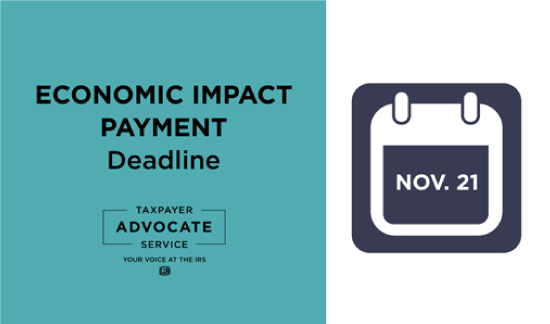
Attention non-filers – the cutoff to register for an Economic Impact Payment (EIP) is fast approaching. To claim your EIP, you should register using the Non-Filers: Enter Payment Info Here tool by 3 p.m. (Eastern Time) on November 21.
Taxpayers who normally are not required to file a federal tax return have more time to claim the EIP this year. Taxpayers with incomes below $24,400 for married couples, and $12,200 for single individuals who cannot be claimed as a dependent by someone else, do not typically have a filing requirement. For more details about filing requirements in general, see Table 1-1 in IRS Publication 17.
IRS Nov. 10 ‘National EIP Registration Day’ (link)
If you are unable to use the Non-Filers: Enter Payment Info Here tool, watch IRS.gov for more information about support from IRS partner groups inside and outside of the tax community, including those that work with low-income and underserved communities for available help options. Low Income Taxpayer Clinics
Some Low Income Taxpayer Clinics (LITCs) may be able to help individuals whose household income does not exceed 250 percent of the Federal Poverty Guidelines with completing the IRS Non-Filers tool or filing a 2019 tax return in order to claim the EIP.
These LITCs have stepped forward to provide assistance to eligible taxpayers for claiming the EIP, subject to availability of services. Some LITCs serve only specific geographic areas, so it is recommended that taxpayers contact an LITC near them, when possible.
Anyone who is not required to file a federal tax return but is eligible for an EIP, did not already register for an EIP, and did not already receive an EIP, must use the Non-Filers: Enter Payment Info Here tool to claim a payment by 3 p.m. (Eastern Time) on November 21. The IRS cannot issue EIPs after December 31, 2020. Using the tool and requesting direct deposit is recommended, so the IRS has time to process the information and issue EIPs to eligible taxpayers prior to that date.
The extended claim date also applies to:
- Social Security, Railroad Retirement and Department of Veteran Affairs benefit recipients, who already received a $1,200 payment, but who wish to register for a payment for their spouse or qualifying child.
- For more information, see Topic H: Social Security, Railroad Retirement and Department of Veteran Affairs benefit recipients.
- Incarcerated individuals –for the most up to date information about incarcerated individuals and EIP claim options, see Economic Impact Payment Information Center — Topic A: EIP Eligibility.
Anyone using the Non-Filers tool can speed up the arrival of their payment by choosing to receive it by direct deposit. Those not choosing this option will get a check.
Beginning two weeks after they register, people can track the status of their payment using the Get My Payment tool.
If you miss this deadline, you will need to wait until next year and claim the payment as a credit (known as the Recovery Rebate Credit) by filing a 2020 tax return.
Alternative claim submission instructions
If you can’t or don’t want to submit the information online using the Non-Filers: Enter Payment Info Here tool, you can still use the tool to enter the required information and then print and mail in the document. Do not submit the information twice.
If you submit a printed form, double-check that “EIP 2020” is at the top of the document. Mail the printed document to the IRS address for your state, without payment.
The IRS won’t have the information necessary to issue you a payment unless you provide some basic information about yourself, your spouse, and any qualifying child under age 17. Entering your bank account information will allow the IRS to deposit your payment directly in your account. Otherwise, your payment will be mailed to you.
Help Spread the Word
If you have already received your EIP, you may be able to help your relatives and friends to receive theirs. If you’re reading this article and know others who may be in this particular position, as described above, and have not received their EIPs, let them know there is still time. Spread the word!
Source: taxpayeradvocate.irs.gov

Leave a Reply